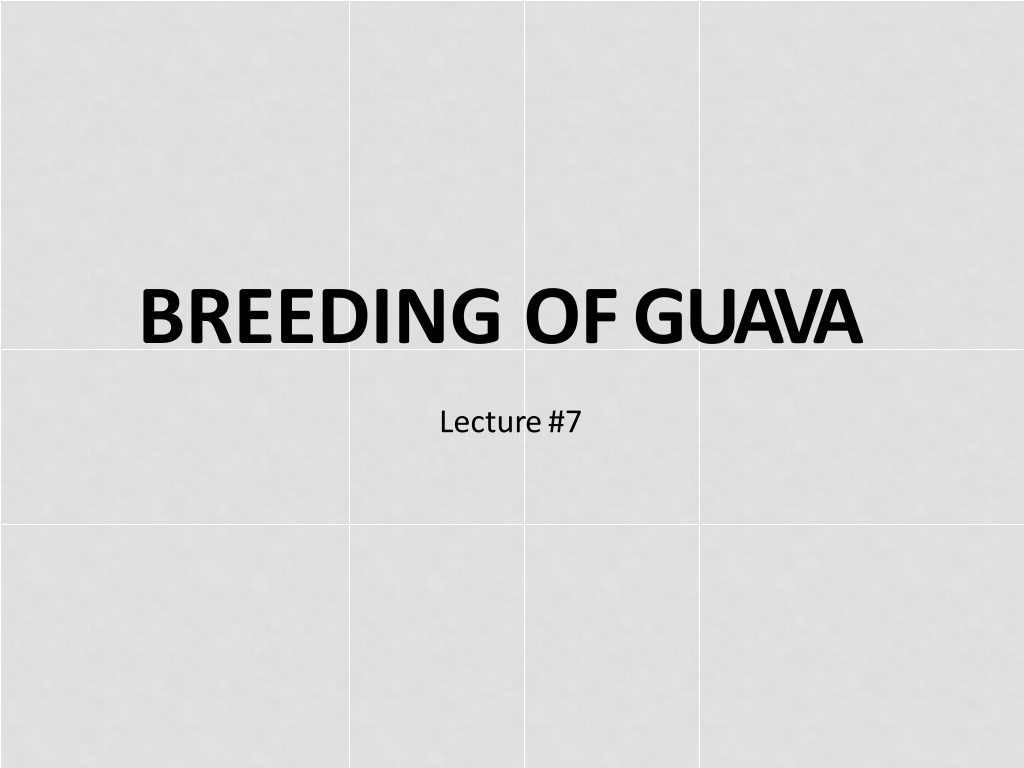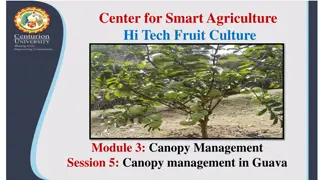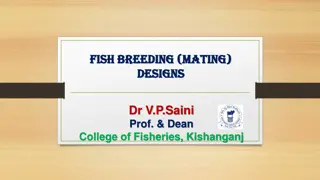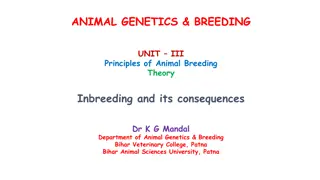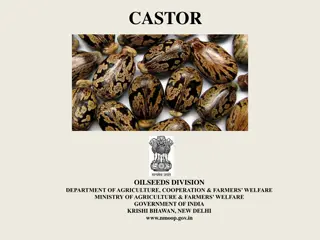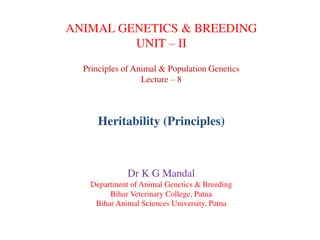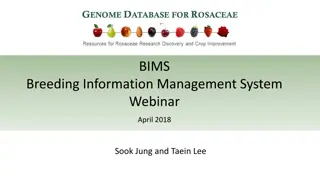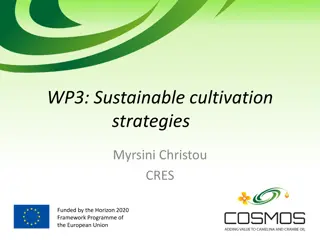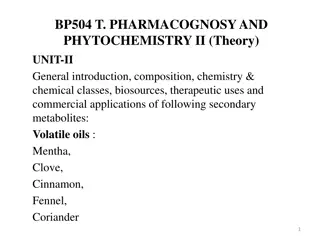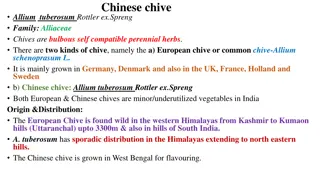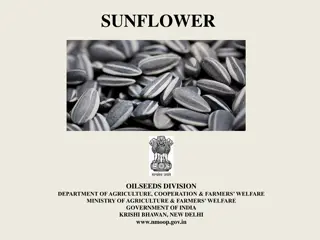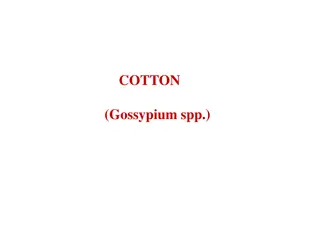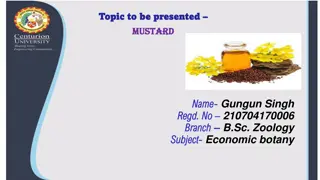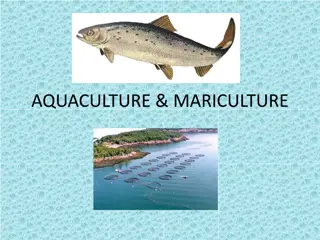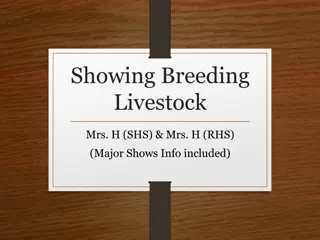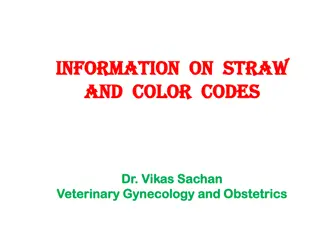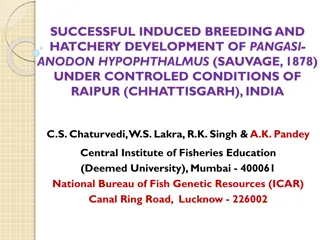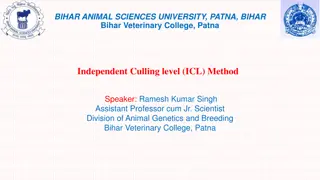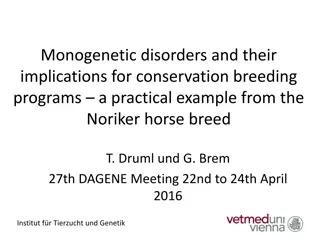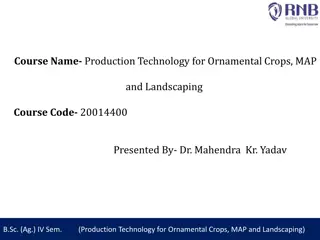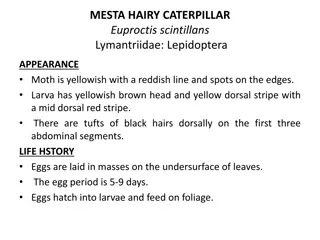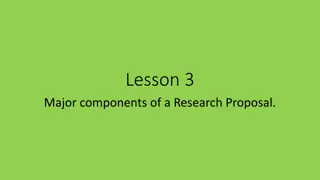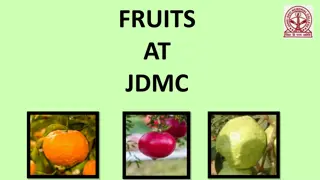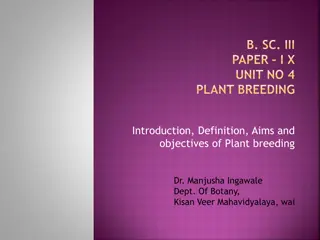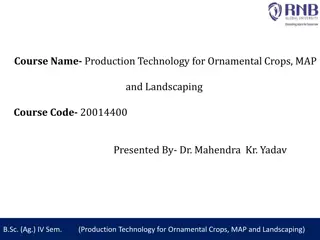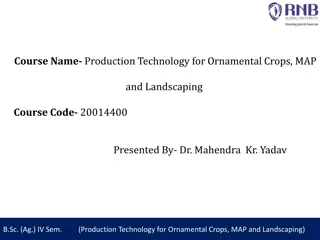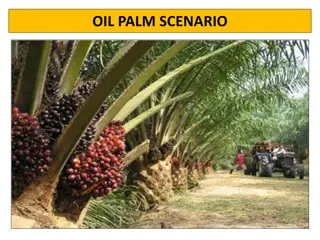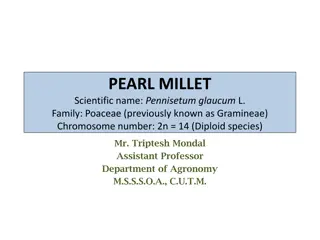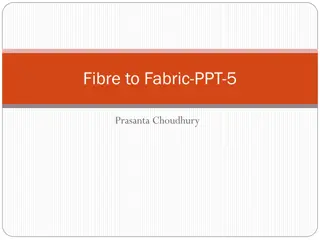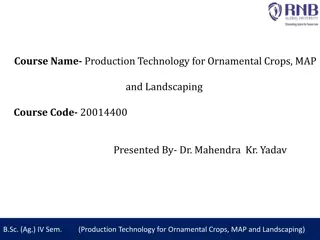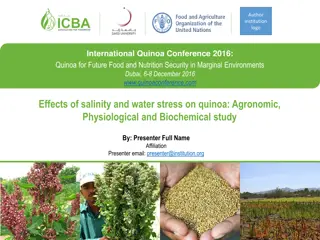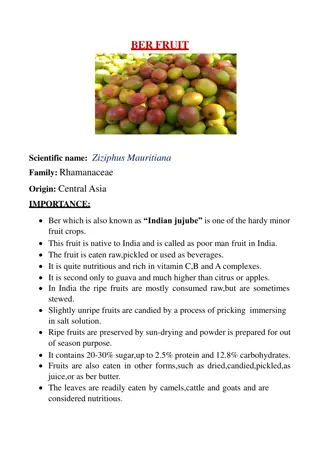Guava Breeding: Strategies and Objectives for Improved Cultivation
Guava, a hardy fruit grown in various states in India, has significant breeding objectives such as developing seedless varieties, enhancing pectin content, achieving uniform ripening, and improving resistance to pests. Various genotypes and floral biology aspects play a role in the breeding process.
Download Presentation

Please find below an Image/Link to download the presentation.
The content on the website is provided AS IS for your information and personal use only. It may not be sold, licensed, or shared on other websites without obtaining consent from the author. Download presentation by click this link. If you encounter any issues during the download, it is possible that the publisher has removed the file from their server.
E N D
Presentation Transcript
BREEDING OFGUAVA Lecture#7
GUAVA B.N.: Psidium guajava L. Family: Myrtaceae Chromosomenumber 2n-2x-2 Origin: TropicalAmerica
Important guava growing states in the country are Uttar Pradesh,Bihar,Madhya Pradeshand Maharashtra. Allahabad district of Uttar Pradeshhas the reputation of growing the best quality of guava fruits in the world. The importance of guava is due tothe fact that it is the hardy fruit which can be grown in alkaline and poorly drained soil.
Germplasmresources: Guava is mainly a self pollinated crop but occurrence of cross pollination results in great variationin the seedling population. About 103 genotypes are available in the Indian collections Yadav(1990) has listed 153 genotypes including Psidium species, cultivars and hybrids mainly at CISH, Lucknow, IIHR, Bangalore,NDUAT ,Faizabad, and HAU, Hisar .
Breedingobjectives 1. Developmentof seedlessvariety 2. Less pectin contentforedible purpose 3. More pectin content for processing 4. Uniform ripening 5. High keeping quality 6. Resistance to tea mosquito bug and wilt.
Botany Most of the Cultivars of Indian guava belongs to the genus Psidium and species gujava. Based on the shape of common guava fruits, they are classified into two groups i.e. Psidium pyriferum,Psidium pomiferum.
FLORALBIOLOGY Guava bears flower solitary or in cyme of two to three flowers,on the current season growth in the axilof the leaves. About one month is required from flower bud differentiation tocomplete development upto calyx cracking stage.
Peak time of Anthesis is between 5.00-6.30 AM in most of the varieties of guava. The dehiscence of anthers starts 15- 30 minutes after Anthesis and continues fortwo hours. The pollen fertility is high in almost all the cultivars. The pollen fertility is 78% and 91% in Allahabad Round and Lucknow Safed, respectively.
Inheritancepattern Bold seed is found to be dominant over soft seed and governed monogenically. Red flesh coloris dominant to white pulp color and also governed monogenically. Red fleshed cultivars are supposed to be heterozygous. There is linkage betweenred flesh colorand bold seed size. Triploidy and some other genetic factors are responsible forfemale sterility.
Breedingmethodsand achievements Clonal Selection Hybridization PolyploidyBreeding
CLONAL SELCTION Improvement work in guava was started for the first time in the country in 1907 at Ganesh khand fruit Research Station, Pune primarily with the collectionof seeds of varieties,grown in different places to isolate superior strains. AtHorticultural Research Station, Saharanpur, evaluationof seedlingtypes resulted in a superior selection, S-1, having goodfruitshape, fewseeds, sweet tasteand high yield. At IIHR, Bangalore, from 200 open pollinated seedlingsof varietyAllahabad Safedacollected from Uttar Pradesh, one seedling selection, selection-8, was found to be promising.
S.N o Varieties Importantcharacters L.49 Developed at GFES, Pune, Seedling selection of Allahabad Safeda, Semi dwarf tree, high yielding 1 Banarsi Surkha It is a selection from local red fleshed type, heavy bearer, large fruits, flesh soft and pink. 2 CISHG-1 Developed at CISH, Lucknow. Fruit skin color is deep red, TSS 15 Brix, soft seeds. 3 Bangalore Local It is a local selection, with white flesh and soft seeds, fruit is large. 4 Arka Mridula (Sel -8) Developed at CISH, Lucknow, it is a selection from apple color seedling, skin and flesh color is pink with good acid sugar blend. 5 Plant prabhat Seedling selection from GBPUAT,Pantnagar, Prolific bearer, soft seed with good quality 6
Hybridization At IIHR, Bangalore, as a result of hybridization among Allahabad Safeda, Red FleshChittidar,Apple color,Lucknow-49 and Bananas, 600 F1 hybrids wereraised. One hybrid Arka Amulyahas been released recently. It is a progenyfromthe cross Allahabad Safedax Triploid. Hybrid16-1 (Apple color x Allahabad safeda) has been developed.
At Fruit Research Station, Sangareddy (Telangana), inter-varietal hybridization resulted in the isolation of twosuperior hybrids. Safed Jam: This is a hybrid between Allahabad Safedaand Kohir(a localcollection from Hyderabad Karnataka region). It is similar to Allahabad Safeda in growth habit and fruit quality.The fruits are biggerin sizewith goodqualityand fewsoft seeds. Kohir Safeda: It is a hybrid between Kohir x Allahabad Safeda, Treeis vigorous, fruits arelarger with fewsoft seeds and white flesh. CISH,Lucknow isolatedtwohybrids H-136 forred pulp and Softseelerwith high TSS.
Haryana AgriculturalUniversity,Hisar has released twohybrid varieties. Hisar Safeda: It is a cross between Allahabad Safeda x Seedless ,which has upright growth with a compact crown. Its fruits are round, weighing about 92g each, pulp is creamy white with less seeds, which are soft, TSS is 13.4% and ascorbic acid 185 mg/100g. Hisar Surkha: It is a cross between Apple Color x Banarasi Surkha . Tree is medium in height with broad to compact crown, fruit is round weighing 86g each. Pulp is pink having 13.6% TSS.0.48% acidity and 169 mg/100g ascorbicacid. Yield is 94 kg/tree/year
Breedingfor wilt resistance Work at CISH, Lucknow has shown that Chittidar, Portugal, Seedless and Spear Acid are tolerant to wilt.
Polyploidy Breeding Producing triploids will be futile since the fruit shapein triploidis highly irregularand misshapen becauseof differentialseed size. However, in order to evolve varieties with less seeds and increasedproductivity,crosses were made at IARI, New Delhi,between seedless triploid and seededdiploid variety Allahabad Safeda. Of the 73 F1 hybrids raised 26 were diploids, 9 trisomics 5 double trisomics and 13 tetrasomics. Distinct variationin tree growth habit and leafand fruitcharacters was observed.
Three trisomic plants had dwarf growth habit and normalshapeand sizeof fruits with fewseeds. The imbalance in chromosome numbers in aneuploids imparted sterility resulting in seed reduction in fruits.
B R E E D I N G I N B A N A N A LECTURE#4
Botanicalname:Musasp. Family:Musaceae Chromosomenumber:n=11 2n=22,33or44. Origin:SouthEastAsia
Historyof banana breeding: Banana breeding was started in Trinidad, West Indies in 1922and in Jamaica in 1924. The driving force for this breeding programme was to develop improved Fusarium wilt (Fusarium oxsyorum F .sp.Cubense)resistant banana forexport trade. In 1960, both the programmes were combined under the Jamaica Banana Board. United Fruit Companyalso starteda small breeding programme in Panamain 1920s. In India hybridization work was started at Central Banana ResearchStation, Adhuthurai,TamilNadu in 1949. Importantbanana growingstatesareMaharashtra, Karnataka, Kerala, TamilNadu, AndhraPradesh, Orissa,Bihar, WestBengaland Assam .
In South India, other than its edible use, banana is extensively used in all auspicious occasions such as wedding, festivals and worshippingGod. Banana is a good table fruit, besides, the cultivar Nendranis usedforcooking. Centre of diversity: Edible banana is native to old world especially South EastAsia (Simmonds,1962). Malayan area seemsto be the primary centerof origin of cultivatedbanana (M.acuminata). M.acuminata, was probably introduced into India and Burma whereM.balbisiana is a native species. Naturalhybridizationbetweenthese two speciesmight haveresulted in manyhybridprogenies(AAB,ABBetc .) .
Genetic resources Musa has about 50 speciesand this genusisdivided intofivesections: a) Eumusa: Includes about 13-15 species of edible and wild banana. The chromosome number is 2n=22 in wild species and most of the cultivated varieties are having 2n=33 (2n=44 rarely) e.g. M.acuminata, M.balbisiana, M.basjoo etc. b) Rhodochlamys: Mostly diploid,spreadfrom India to Indonesia. Five to seven species are kept in this group. Parthenocarpy is absent in this group e.g. M.ornata, M.velutina. c) Callimusa: Thisis of ornamentalvalueand x=10and 2n =20. It is foundin Indo-China,Malaya and Borneo. Parthenocarpy is absent in this type. It includes about 5-6 speciese.g. M.coccinea.
d) Australimusa: Like Callimusa it has x = 10 and 2n=20 chromosome. Species of this group is commonin Queensland and Philippines. Important speciesof this group are M. textilisor manilahemp, M.maclavi etc. e) Incertae sedis: It includes M.ingens (x=7, 2n=14) of New Guineawhich growsto a height of over 10 m. This is the largest known herb. Another species in this group is M.beccarii (x=9, 2n=18) from North Borneo.
The most important Musa cultivars are almost sterile triploids (2n=3x=33) and also tetraploid and diploid bananacultivars havealso localimportance in Asia. All banana and plantain land races are farmers selection fromintraand inter specifichybridization of twodifferent species. M.acuminataColta, donor of the A genome and M.balbisianaColta, donor of the B genome. Simmonds and Shepherd (1955) reported scoring technique to indicate the relative contribution of the two wild speciesforthe constitution of a given cultivar. Fifteen distinguishing characters between Musa acuminata and Musa balbisiana were identifiedby them.
At the botanical garden, Howrah, seeds of few banana specieswere collectedfrom ChittagongandMadras. More number of genotypes of banana was also maintained at Central Banana Research Station, Aduthurai. After that it was shifted to Horticulture college and researchInstitute,TamilNadu Agricultural University, Coimbatore. After the formation of National Research Centre on Banana (NRCB) in 1995, a wide germplasm collection including wild types arebeingmaintained at thiscenter and intensive research programmes are being taken up on various problemsrelatedwith banana. Presently,TNAUalso maintaining 186 collectionsof germplasm.
Taxonomicclassificationof edible banana (Simmondsand Shepherd, 1955) Genome Ploidy level Nomenclature AA 2x Matti, Anai komban Cavendish, Robusta, Grand Nine Bodles Altafort (Synthetic hybrid of West Indies) AAA 3x AAAA 4x AB 2x Ney Poovan, Kunnan AAB Poovan, Hill banana, Champa, Rsathali 3x ABB 3x Monthan, Kanchkela, ABBB 4x Klue Teparod
Objectivesof breeding To develop dwarf statured banana suitable for high density planting and to prevent damage from high wind velocity. Productionof good quality fruits. Resistant to biotic and biotic stressesi.e. nematodes, panama wilt, bunchy top, sigatoka leaf spot, moko diseaseand pseudo stemweeviletc. T odevelopvarietieswith wider agro-ecological adaptability. Developmentof male fertileparthenocarpic diploids with resistancetomajor diseasesandpests. Developinglonger fingersize. Suitabilityforexport. Good keepingquality.
Breedingmethodsand achievements: Introduction. Hybridization Mutationbreeding Breedingworksof different areas
Introduction Introduction of some cultivators of banana was made with resistance to biotic stresses e.g. Lady Finger (EC 160160) resistant to bunchy top virus introduced from Australia and is being evaluated at IIHR, Bangalore and TNAU, Coimbatore. Further,cultivars Naine MS (EC 27237) fromFrance and Valery from West Indies were introduced for utilization in improvement programme
Hybridization In India, breeding work was started at Central Banana Research Station, Aduthurai (TamilNadu) in 1949. Technique of hybridization in banana is different fromother crops. Pollination is best carried out in the morning. The bunches of female parent are bagged at shooting and each successive hand is pollinated as it is exposed. At maturity and ripening the bunch is cut and seeds areextracted. Seedsaresown at oncein the green house.
Evaluation of hybrid progenies from seedlings to harvest may not be the correct phase instead, evaluationof the same under next vegetativephase i.e., sucker to harvest stage will be ideal as full expression of yield potential could be observed only in the second cropof the F1 progeny. The firstcrop (seedlingto harvest)takesmore than 15-19 months, where most of the energy of the plants is neededforcorm formation.
HYBRIDIZATION: KallarLaden(AAB) x M balbisiana cv.Sawai (AB) AB X Kadali(AA) CO-1 (AAB)
AtKeralaAgriculturalUniversity,two hybrids viz., BRS-1 (Agniswarx Pisang lilin) and BRS -2 (Vannan x Pisang lillin) have been developed. BRS -1 (AAB) is 100 days earlier than Rasthali with significant differences in bunch weight. It has been released for homestead cultivation in Kerala, as it is resistant tosigatokaleaf spot. BRS-2 (AAB) is a medium statured hybrid, tolerant to leaf spot and panama disease, rhizome, weevil and nematodes. The average bunch weight is 14 kg with 8 hands and 118 fruits crop duration of 314 days.
Breedingwork in other Countries: PITA-9:A Black SigatokaResistant(BSR) hybrid from the False Horn plantain, a tetraploid hybrid having black Sigatoka resistance has been developed at International Institute of Tropical Agriculture(IITA),Nigeria. BITA-3 is a tetraploid starchybanana hybrid with low partial resistance to black Sigatoka disease developedat IITAHighRainfall Station in Onne (Southeastern Nigeria), where both (Banana streak virus) and cucumber mosaic virus (CMV) havebeen observed. BITA-3 is a hybrid fromthe interspecific cross Laknau x Taju Lagada , Laknau is a female fertile AAB starchy banana that closely resembles plantains.
Mutationbreeding: Bud mutation in Indian banana is very common perhaps due to spontaneous rearrangement of chromosomes in somatic meristem and structural re-assortment. High gate(AAA) is a semi-dwarf mutant of Gros Michel (AAA), Motta Poovan(AAB) is a sportof Poovan (AAB), AyirankaRasthalia sport of Rasthali (or Silk), Barhari Malbhog is a sport of Malbhog, Krishna Vazhaiis a natural mutant of Virupakshi(or Pome), Sambrani Monthan(ABB), a mutant of Monthan (ABB).
Name of theclone/cultivars Name of the biotic and abioticstress Musabalbisiana Drought Calcutta-4 Blacksigatoka PisangLilin Panamawilt(Race1) SH3142(Diploidhybrid) Race 1 of Fusarium Musaacuminataspmalaccensis Race 1 and Race 2 of Fusarium Musaacuminataspburmannica Bacterialwilt race2,Moko Disease Burrowingnematode PisangJari Buaya(PJB) Tongatand Anaikomban Nematodes
